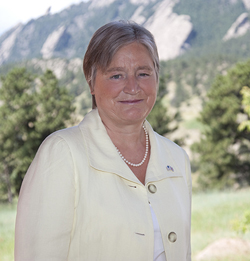A special relationship to tackle new environmental questions
Nov 2, 2010 - by Staff
Nov 2, 2010 - by Staff
2 November 2010 • Until recently, the science of weather and climate has largely been the domain of physicists and mathematicians, but increasingly we need to engage with many other disciplines, from chemistry and biology to engineering and social science. The evolution to a truly interdisciplinary science will pose new challenges but also new opportunities.
At the same time, the modeling, prediction, and computing challenges have grown. This is especially true as we look toward higher-resolution models and seamless prediction systems (the application of the same fundamental methods for predicting the Earth system on a wide range of spatial and time scales). This is driven by a growing understanding that we require a more unified approach to weather and climate science and prediction.

At the UK Met Office, our new five-year science strategy takes this agenda of interdisciplinary, seamless science and prediction and focuses our research agenda around four major science challenges:
Collaboration will be essential for delivering the capability required if we are to provide world-class weather and climate science and services around these challenges in the coming decade. With this backdrop in mind, I have placed the development of strong partnerships at the core of our strategy, and I welcome the new partnership between NCAR and the Met Office on weather and climate research and the technologies that underpin it. (See the NCAR news release from 6 July 2010.)
The Memorandum of Agreement, put in place with the support of the UK Foreign and Commonwealth Office Science and Innovation Network, will see the Met Office and NCAR increase their collaboration to tackle the major challenges of forecasting the weather a few hours and days ahead and predicting the climate for the coming season and decades. Bringing together expert scientists from the Met Office and NCAR will allow both organizations to deliver groundbreaking scientific outcomes in an increasingly efficient manner.
The goals of the partnership are to coordinate ongoing research and to develop and implement future joint projects in new areas of science, such as
The Met Office and NCAR have also been working on other partnership activities. We have jointly promoted the delivery of policy-relevant climate science through a high-profile workshop in Washington, D.C., in September—the first international meeting of the Met Office–led U.K. AVOID programme. AVOID is targeted at providing policy-focused research and evidence to enable policymakers to develop mitigation and adaptation policy strongly grounded in scientific evidence. With partners across the U.K., AVOID integrates research from multiple institutions across the physical, social, and economic sciences. The workshop in Washington was designed to discuss, engage, and partner with U.S. scientists, including those within NCAR and UCAR.
The Met Office and NCAR also organized a workshop toward the end of August on the attribution of climate-related events. The workshop resonated with this summer’s devastating floods in Pakistan and record-breaking heat in Russia, as many questions are now being asked about whether these examples of extreme weather are linked to climate change.
Right now these questions are difficult to answer. It can still be problematic to blame an individual weather event on climate change, because there have always been extremes of weather around the world and our observations of past events are very sparse. However, the evidence is mounting that hazardous weather is increasing in frequency and potentially also in intensity, in line with what our projections suggest.
Precise local information on our evolving climate and related weather patterns, and on how these fit into the longer-term picture, remains insufficient in many of the most vulnerable parts of the world. This is a challenge that we have started to address. In September, scientists from all around the world gathered at the Met Office to begin the development of a new observational record to help identify changing trends in extremes (see the Nature article by Peter Stott on 26 August). NCAR and the Met Office will be key players in this initiative.
Many of the questions now being asked by governments, businesses, policymakers, and scientists cannot be answered by any institution alone. The evolution to a truly interdisciplinary and seamless science can only be realized through strong partnerships, such as the one between NCAR and the Met Office. It is only then that we can we hope to meet the needs of the communities we serve. I look forward with great anticipation to the exciting science that we can do together.